FAMOUS PEOPLE
The pen to the newspaper artist is what the brush is in the hands of the painter.
-Manuel Rosenberg, The Manuel Rosenberg Course in Newspaper Art, 1922

World-Renowned Personalities
Manuel Rosenberg has sketched presidents, kings, popes, scientists, actors, and generals. He has sketched more celebrities than any other artist in the world and is probably the most widely known sketch artist in this country. For years, he amassed a collection of over 20,000 personally autographed celebrity drawings, including those of President Harding, General Pershing, Lloyd George, King Albert of Belgium. Of particular interest is a sketch of Mrs. Harding and the story of how the “first lady of the land happened to pose.”
The Sketch Artist on Tour
On a Monday in December, General John J. Pershing was to arrive in Cincinnati from Louisville. Such an extraordinary famous visitor makes, of course, a very big story. We had many photographs of him, as had other papers. We wanted something original and a story of greeting to Cincinnati from the General’s lips. Therefore as Pershing was to arrive in Louisville on Sunday the reporter and I left for that city Saturday evening. Bright and early Sunday morning we were on the job. The General’s private car was parked within the shed. An admiring throng stood at a respectful distance from the train, which was guarded by a company of soldiers. Being newspaper men we were admitted to the General’s coach. He was eating his breakfast at the moment, with his aide. We asked the captain of the guard permission to interview the General. His reply to our request was that he had orders not to let anyone in to see the noted officer. I immediately returned to the uncurtained coach window, through which I could well see my subject and, despite the biting zero weather, I managed to sketch the large head here shown. Remember this admonition - always get your stuff NOW. You may have a chance to make your sketch later, but that would be to take a chance. Finally my fingers became so benumbed that I could hardly hold my pencil for drawing my sketch. So I forcibly wrote a brief note and addressed it to the General’s aide, which the captain himself brought to him, still seated at breakfast with the General.
The captain soon returned with this information: “The general said to have the artist come in, but to keep the reporter out, as he does not care to be interviewed.”
I went in immediately. Within a moment the General had finished his repast and in true military manner was about to dismiss me so that he might dress. He asked to see my sketch. Quickly I turned the page to the sketch I had drawn in the cold (the large head). It met with his approval and his suggestion to make the nose and chin larger, I carried out to his satisfaction. You will note by this incident the value of getting your sketch early.
-Manuel Rosenberg, Practical Art, 1924

-Practical Art 1924, General John Pershing

General Diaz 1921
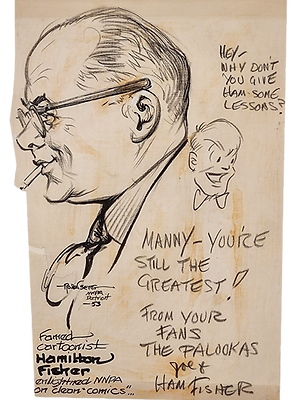
Ham Fisher 1953

Florence Kling Harding 1921

Howard Thurston 1924
Famous People Sketches & Articles
Partial collection signed by Manuel, autographed by famous people,
self-caricatures signed for Rosenberg, and newsclippings

King Tut’s tomb in the Valley of the Kings was the best-preserved ever found. On November 24, 1922, the full extent of the stairway was cleared and a seal containing Tut’s cartouche found on the outer doorway. Once the rubble-filled corridor was clear the tomb was revealed.
Sponsored by the English aristocrat, Lord Carnarvon, Carter did not know whether true treasures would be found inside the tomb. When Carnarvon asked, “Can you see anything?” Carter famously replied, “Yes, wonderful things.” This was a legendary discovery and the crowning achievement of his life’s work. The intact tomb belonging to the “boy king” was a breathtaking find. In the decade that followed, Carter and his team would methodically excavate the contents, which included the Pharaoh’s mummified body, jewelry, furniture, religious artifacts, and everything a king needed to accompany him into the afterlife.
In 1922, Egyptian motifs became especially popular after the discovery of the tomb of King Tutankhamen.
In 1939, after succumbing to Hodgkin’s disease, a quote from the Wishing Cup of Tutankhamen appears on his epitaph: “May your spirit live, may you spend millions of years, you who love These, sitting with your face to the north wind, your eyes beholding happiness.”
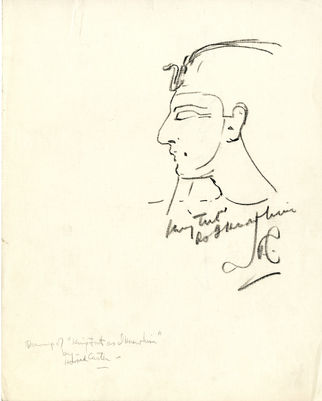
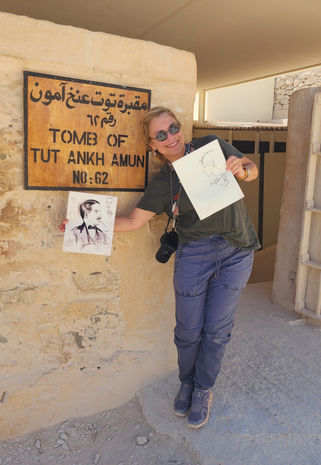
“The glory of kings is to seek out a matter.” Howard Carter who discovered the glory of a king long dead knew a greater satisfaction than even kings know. To him the habits and lineaments of Tutankhamen, ruler of ancient Egypt, were as familiar as his own. “Here’s the young fellow himself, as I knew him.” To have come upon this great ruler as he lay in state surrounded by the pomp and panoply of his time. To read upon the walls of his tomb, his life, his ambitions, his death; to be able to sketch line for line his profile..to say: “King Tut was a young fellow” so easily, so intimately. It all made me wonder where the glory of the kings has gone... to wonder in what our glory will lie, three thousand years from now."
I brought Uncle Manuel's Carter and Tut drawings with me and posed by King Tut's tomb as a homage. My uncle may have not been there for the discovery, but his interview and sketches of the famous discoverer brought him closer than any of us will ever get.

Their eyes have an eagle look; these men who have conquered the sky, and I always feel so earthbound in their presence. When I dined in Rome with Caproni, the great Italian airman, I felt this keenly. I thought of the realms of cloud and blue to which he had attained, I felt very small. But then, with kindly intent, he spoke of my world; my heroes’; Raphealo Tintoretto, Fra Lippo Lippi. He said quite shyly that he too loved to paint and made for me the little sketch of myself reproduced above. The heroes of my world soared too, into the spiritual cloud and blue of inspiration... but it was Italy that nurtured them. The same Italy that producer this eagle...this Signor Caproni."
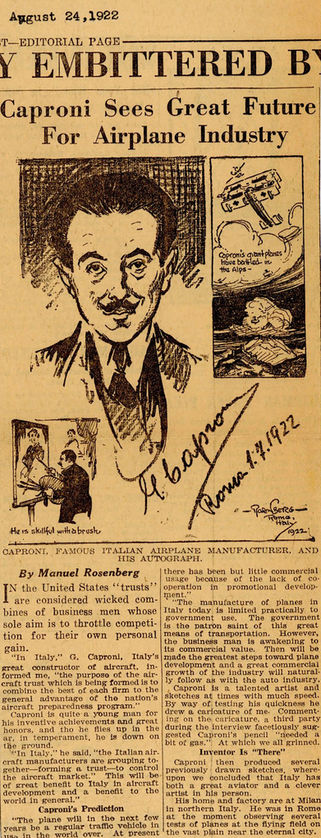
By Manuel Rosenberg
IN the United States “trusts” are considered wicked combines of business men whose sole aim is to throttle competition for their own personal gain. “In Italy,” G. Caproni, Italy’s great constructor of aircraft, informed me, “the purpose of the aircraft trust which is being formed is to combine the best of each firm to the general advantage of the nation’s aircraft preparedness program.” Caproni is quite a young man for his inventive achievements and great honors, and tho he flies up in the air, in temperament, he is down on the ground. “In Italy,” he said, “the Italian aircraft manufacturers are grouping together—forming a trust—to control the aircraft market.” This will be of great benefit to Italy in aircraft development and a benefit to the world in general.”
Caproni’s Prediction
“The plane will in the next few years be a regular traffic vehicle in use in the world over. At present there has been but little commercial usage because of the lack of cooperation in promotional development.” “The manufacture of planes in Italy today is limited practically to government use. The government is the patron saint of this great means of transportation. However, the business man is awakening to its commercial value. Then will be made the greatest steps toward plane development and a great commercial growth of the industry will naturally follow as with the auto industry. Caproni is a talented artist and sketches at times with much speed. By way of testing his quickness he drew a caricature of me. Commenting on the caricature, a third party during the interview facetiously suggest Caproni’s pencil “needed a bit of gas” At which we all grinned.
Inventor Is “There”
Caproni then produced several previously drawn sketches, whereupon we concluded that Italy has both a great aviator and a clever artist in his person. His home and factory are at Milan in northern Italy. He was in Rome at the moment observing several tests of planes at the flying field on the vast plain near the eternal city.
Cincinnati Post - August 24, 1922
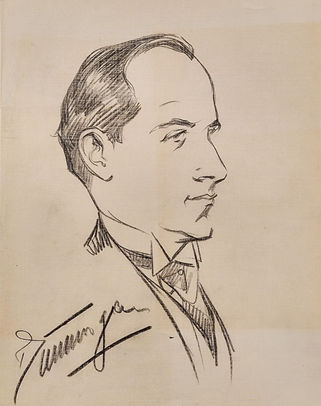
Born in New York City, he headlined throughout the Keith-Orpheum Circuit and was in demand for private entertainment.
At the age of seventeen, he performed at the homes of Teddy Roosevelt and Thomas Edison. He wrote the book "Inside the Medium’s Cabinet" in 1935, which exposed the tricks of mediumship. He also exposed how the Indian rope trick could be performed by camera tricks. In 1935, Dunninger attended a séance of the fraudulent medium, Emerson Gilbert. His testimony was used in court against Gilbert. A good friend of Harry Houdini, Dunninger acted as technical advisor of the 1953 biopic, Houdini, starring Tony Curtis.
During the 1950s and '60s, he was the basis of two recurring comedic characters, “The Amazing Dillinger,” played by Johnny Carson, and “Gunninger the Mentalist” on the Soupy Sales comedy TV show. In I Love Lucy, Lucille Ball’s character brags to Ricky, “Just call me Dunninger.” And in a Columbo episode, antagonist Jack Cassidy says, “It’s an old stand by... Dunninger used it in his act.”


He had been reading the minds of the rest of the newspaper men whom he was entertaining at dinner. I was certain he had read mine when he turned to me and asked for a pencil: “Here’s an idea of what I can do with a pencil,” he said and forthwith set out to draw for me. Just what I had been wishing him to do! I was glad too, that I had not let my mind wander into goodness knows what fields as artists are prone to. It wouldn’t be safe around Joseph Dunninger!
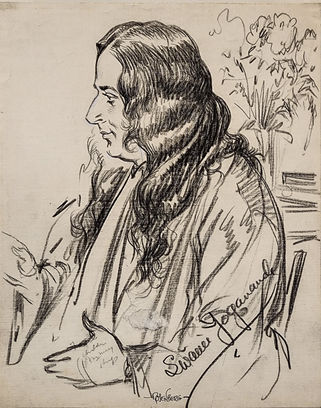
He immigrated to America at the age of twenty-seven to prove the unity between Eastern and Western religions and to preach a balance between Western material growth and Indian spirituality. His long-standing influence in the American yoga movement, and especially the yoga culture of Los Angeles, led him to be considered by yoga experts as the “Father of Yoga in the West.” He lived his last thirty-two years in America.
Yogananda was the first prominent Indian to be hosted in the White House by President Calvin Coolidge in 1927. During this time, he attracted a number of celebrity followers, including soprano Amelita Galli-Curci, tenor Vladimir Rosing, and Clara Clemens Gabrilowitsch, the daughter of Mark Twain. His early acclaim led to him being dubbed “the 20th century’s first superstar guru” by the Los Angeles Times.
In 1920, he embarked on a successful transcontinental speaking tour before settling in Los Angeles in 1925. For the next two-and-a-half decades, he gained local fame and expanded his influence worldwide: he created a monastic order and trained disciples, went on teaching tours, and bought properties for his organization in various California locales. By 1952, SRF had over 100 centers in both India and the United States.
He published his "Autobiography of a Yogi" in 1946 to critical and commercial acclaim. It has sold over four million copies and was selected as one of the “100 best spiritual books of the 20th Century.”
In 1926, Yogananda came through Cincinnati on a speaking tour. He planned to establish a Yogoda Institute in Cincinnati and held luncheons with rich society ladies to promote the idea, which never materialized. American women in the 1920s flocked to his events; he had long hair and was exotic.
Yogananda was put on a government watch list and kept under surveillance by the FBI and the British authorities. A confidential file was kept on him from 1926 to 1937 due to concern over his religious and moral practices.
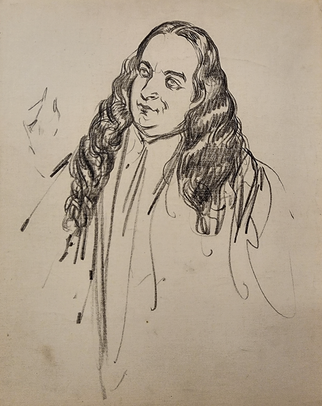
I know just how a Chinaman, (a cultured Chinaman) must feel when faced by a very nice American Missionary. For I felt like that when I met Swami Yogananda; a little touched that so great a gentleman should have come so far to save me... and a little amazed. In his orange colored robes, with his long black hair, he seemed very, very foreign. Only the spirituality of his face was familiar to me. I had seen that look before. There are many good men in the world, I find. He posed for me graciously and then said: “I will be pleased to make a drawing of myself for you.” I was not at all surprised. But when a few days later his secretary punctiliously sent me the accompanying drawing, I was, I admit agreeable so. He had said modestly that it would not be as good as mine, but actually it looks like the Swami...indeed in some ways more than my impression does.


Cincinnati Post - October 4, 1926

In 1904, thousands watched in suspense for an hour as he tried to escape from handcuffs commissioned by London’s Daily Mirror. Another stunt saw him buried alive and only just able to claw himself to the surface, emerging in a state of near-breakdown. While many suspected that these escapes were faked, Houdini presented himself as the scourge of fake spiritualists. As president of the Society of American Magicians he was keen to uphold professional standards and expose fraudulent artists.
Manuel sketched Houdini during a séance in Cincinnati in 1925.

Sketches made by Manuel Rosenberg, Post Artist, at test seance given for the benefit of Houdini by Lois and George McGehan. John Soetje, cigar manufacturer, was a witness to the test, photograph shows Mrs. Jemell Williams, the mother.
By Alfred Segal
HARRY HOUDINI called “the spirit that writes books” at 4451 1/2 W. McMicken avenue. This spirit dictates books, short stories and letters thru her daughter, Mrs. Lois McGhen, and in a personal letter had invited Houdini, the magical, to call on her so that she might prove to him that she is a true literary spirit. Now Houdini is hunting everywhere for genuine spirits and has offered $5000 for one that proves real to his satisfaction So he promptly accepted the invitation from the spirit of Mrs. Jemell Williams, who died twenty-six years ago.
Kentucky Post - April 10, 1925

Because of her immense popularity and prominent social acquaintances, Lenglen is recognized as the first female athlete to become a global sport celebrity. She was also the first leading amateur to turn professional, and was ranked as the greatest women's tennis player from the amateur era in the 100 Greatest of All Time series.
Lenglen was referred to by the French press as La Divine (The Goddess), embodying her mythical persona and perceived infallibility at tennis. She revolutionized the sport by integrating the aggressive style of men's tennis into the women's game and breaking the convention of women competing in clothing unsuitable for tennis. She also incorporated fashion into her matches, highlighted by her signature bandeau head-wear. Lenglen's popularity led Wimbledon to move to its much larger modern-day venue.
Lenglen was inducted into the International Tennis Hall of Fame in 1978, and the second show court at the site of the French Open is named in her honor.
Manuel's typed notes from the Columbia Collection: I regret that cannot delight you with a drawing by Susanne Leglen, the Worlds foremost tennis star. Susanne like most French stars is very temperamental and during our conversation she hinted that she too could draw, “un peau”. So I struck up a bargain with her. She was to make a drawing for me and in exchange I would give her the original I drew of her. “Bien.” All was well and agreed upon and Sussanne in her best English amused me while sketching with a few snappy stories that were just a bit too rique to print when she suddenly asked what I might do with the drawing. “Ah, I do not draw well enough for publication,” she hastily informed me – and nothing – nobody – not even her burly massure who handled her always minus silk gloves could get her off her temperamental determination not to show her “lack of ability”.
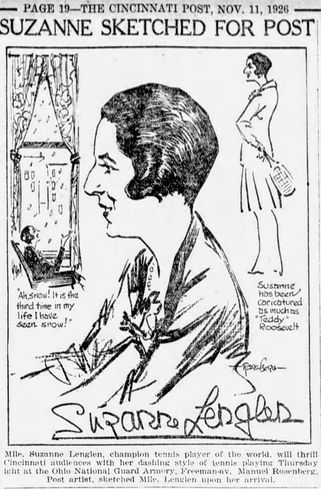
Mlle. Suzanne Lenglen, champion tennis player of the world, will thrill Cincinnati audiences with her dashing style off tennis playing Thursday night at the Ohio National Guard Armory, Freeman-av. Manuel Rosenberg, Post artist, sketched Mlle. Lenglen upon her arrival.
Cincinnati Post - November 11, 1926

Born in Naples, Diaz began his military career as a student at the Military Academy of Turin. In 1921, Diaz was in Kansas City to attend the groundbreaking ceremony for the Liberty Memorial. Also in attendance were General Baron Jacques of Belgium, Admiral David Beatty of Great Britain, Marshal Ferdinand Foch of France, and General John J. Pershing of the United States. Vice President Calvin Coolidge was one of the main speakers. In 1935, bas-reliefs of Jacques, Foch, Diaz, and Pershing by sculptor Walker Hancock were added to the memorial.
Manuel met and sketched Diaz in 1921, when he was in Cincinnati celebrating his 60th birthday. The general, in return, drew a Venetian nobleman for Manuel, which was featured in the Library Art Room Exhibition.

Italy whose warm bosom nurtures both art and heroism! The one country that could have produced this man. A soldier whose spiritual wisdom leads him to speak in the name of peace; a soldier whose speech had the flavor of true poetry. Indeed, I should have been disappointed in him, had he not proved himself, as well, an artist. In one day he captured in a single victory, two-hundred thousand Austro-Hungarians and halted the enemy advance upon the frontiers of his beloved country. In one small hour he won the hearts of the distinguished company who heard him speak at the huge banquet given in his honor on his sixtieth natal day. With a few sketched lines he subjugated the artist in me, who must ever acknowledge and acclaim his fellow."

General Armando Diaz,who was Cincinnati’s guest on his sixtieth birthday anniversary Monday, is quite adept with the pencil. Like his distinguished countryman, the late Enrico Caruso, he amuses himself by drawing caricatures of his staff. As Manuel Rosenberg, Post sketch artist, sketched the Italian hero, the latter borrowed the artist’s pad, and in a few moments drew the above picture, which he presented to the artist. Asked who the subject was meant to be, Diaz gesticulated. It appears to be the character of an ancient Venetian nobleman, similar to those painted by the Italian artists of the seventeenth century.
Cincinnati Post - December 6, 1921
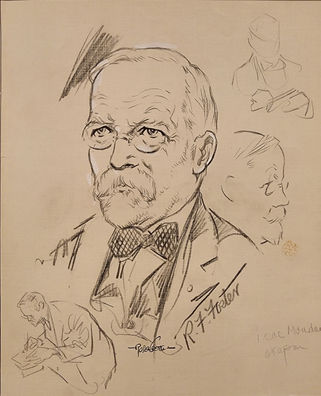
Born in Edinburgh, Scotland, he grew up connected with some of the best families in Great Britain. He was educated as an architect and civil engineer. Foster emigrated to the United States around 1872, where he was engaged in prospecting before he turned to memory training.
He became a card editor for the New York Sun in 1895 and New York Tribune, and a columnist for Vanity Fair. Foster’s "Complete Hoyle: An Encyclopedia of All the Indoor Games Played at the Present Day," first published in 1897, was included in the 1939 New York World’s Fair Westinghouse Time Capsule, to be opened in 5,000 years.
Manuel's typed notes from the Columbia Collection: "R. F. Foster is one of a very small number of men who not only understand the great game of Bridge but are also able to set forth its basic rules with clearness and to expound its intricate subtitles without confusing the student. Although an authority on Bridge he is also a master of other card games and has written books on and about them. He is, sub rosa, recognized as the “Hoyle” of today.
The man who never “renigs”... did not disappoint me. To play expert bridge one must have a facility of mind, a co-ordination which few other indoor games call out. “I draw to amuse my grandchildren.”.. an original excuse. I hope to use it myself someday. “You see, the dollbaby face is my favorite trick. I tell the youngsters not to touch the baby’s nose or it will awaken.. so of course they immediately disobey me to see if ‘that is so.’ Then I quickly drew a semi-circle above the lower closed eyelid and add a dot for the eye and the baby ‘awakens.’ Try it.” Someday I will, Mr. Foster. In the meanwhile I trust that all of your trumps wont be little ones. Spare a few...for the rest of us."
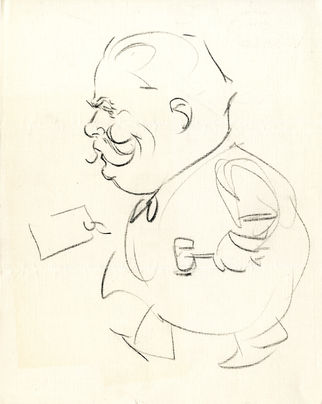
-Excerpt from Practical Art
How does one set about obtaining an interview with a celebrity?” the student will ask. For answer I may cite my experience in interviewing Chief Justice William H. Taft, of the United States Supreme Court. The telegraph editor of my paper received a wire from our Washington correspondent – “Judge Taft leaves tonight for Cincinnati to attend the convention of the American Bar Association, which is being held there.” Telegraph editor turned the notice over to the city editor, who assigned a reporter and myself to the interview. The former President of the United States is always well worth a big local “story,” particularly in Cincinnati, which is his hometown. The reporter and I usually call at the hotel, or wherever our subject is located – information which we always obtain through various sources, or by means of our own deductions. A prominent man naturally will stop at the leading hotel -and you will be apt to find him there. From the hotel register or the clerk you obtain the information that “the visitor is in room No. -. You or the reporter call up the room on the house phone. The visitor or his secretary answers. The reporter says: “This is a reporter for the Post,” say. “My paper would appreciate an interview with Judge Taft, and we would like to get the story for today’s edition. I have our sketch artist with me.” You are invited to come up to the room immediately. The sketch is drawn during the interview. In this particular case, we found Judge Taft in his shirt sleeves, writing, when we called. He invited us in, but was very reticent to talk on subjects of national importance. When asked to express his views on certain matters he rose, grasped the reporter by both shoulders, and replied with a vast chuckle: “My dear boy, I can say nothing. I hardly dare give an opinion on the weather since I have become Chief Justice. There is no somber formality about an interview. Unless you have specific questions to ask, you quiz your subject along whatever lines you may think best. Your questions may even be very personal – though, of course, always asked with a proper degree of reserve. Judge Taft was asked as to the form customarily used in addressing a chief justice. “Well, son” he replied, with another chuckle, “in Washington they call me ‘Mr. Chief Justice.’ But I like my friends to call me ‘Judge Taft’ when they call me anything. So suppose you just call me ‘Judge.’”
Manuel was a peer and friends of Taft's son, Charles P. Taft. Manuel illustrated the famous murder trial of George Remus, Charles Taft's first case as a prosecutor.

Taft was born in Cincinnati, Ohio. His father, Alphonso Taft, was a U.S. attorney general and secretary of war. He attended Cincinnati Law School, and graduated in 1880. While in law school, he worked on the Cincinnati Commercial newspaper. Taft was assigned to cover the local courts, and also spent time reading law in his father’s office; both activities gave him practical knowledge of the law that was not taught in class.
Shortly before graduating from law school, Taft went to Columbus to take the bar examination and easily passed. Taft attended Yale and joined the Skull and Bones, of which his father was a founding member.
After becoming a lawyer, Taft was appointed a judge while still in his twenties. He continued a rapid rise, being named solicitor general and a judge of the Sixth Circuit Court of Appeals.
In 1901, President William McKinley appointed Taft civilian governor of the Philippines. In 1904, Roosevelt made him secretary of war, and he became Roosevelt’s hand-picked successor. Despite his personal ambition to become chief justice, Taft declined repeated offers of appointment to the Supreme Court of the United States, believing his political work to be more important. The Taft family is a Cincinnati dynasty.

WHEN CHIEF EXECUTIVE AND PARTY PAID FLYING VISIT TO CINCINNATI
Below are sketches of President and Mrs. Hoover, made from life by Manuel Rosenberg, Post staff artist, as they stepped from the train.
Cincinnati Post - October 22, 1929
Herbert Clark Hoover (August 10, 1874-October 20, 1964) was an American politician who served as the 31st president from 1929 to 1933. A member of the Republican Party, he held office during the Great Depression. A self-made man who became rich as a mining engineer, Hoover led the Commission for Relief in Belgium, served as the director of the U. S. Food Administration, and U. S. secretary of commerce.
Born to a devout Quaker family in West Branch, Iowa, his parents died when he was small. He went to live with his aunt and uncle in Oregon. Hoover was one of the first graduates of the new Stanford University in 1895. While at Stanford, he met his wife, Lou Henry. Lou was an American philanthropist and geologist. She was involved in the Girl Scouts of America and supported women’s rights and independence along with her husband. They had two children.
In his early twenties, he circled the globe five times. Herbert Hoover lived through the Boxer Rebellion in China, hacked through the jungles of Borneo, rode camels across Western Australia, rubbed shoulders with Wyatt Earp in a Klondike saloon, and camped beside the Great Pyramids of Egypt.
While in Cincinnati, President Hoover dedicated a monument in Eden Park, “My fellow countrymen and women. It is a great pleasure for me to share in the dedication of this monument glorifying for all time the completion of a nine-foot channel for the full length of the Ohio River.”
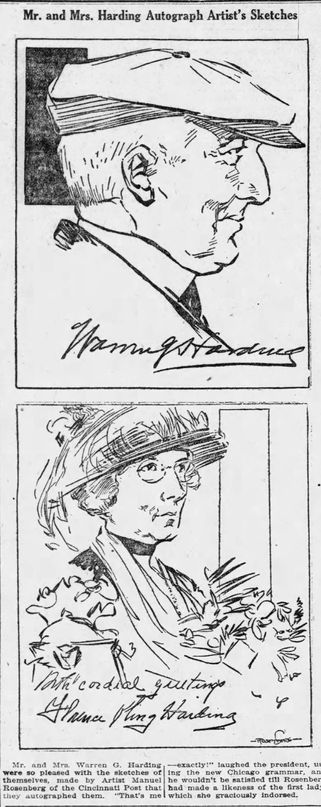
Mr. and Mrs. Warren G. Harding were so pleased with the above sketches of themselves, made by Artist, Manuel Rosenberg of the Cincinnati Post that they autographed them. “That’s me—exactly!” laughed the president, using the new Chicago grammar, and he wouldn’t be satisfied till Rosenberg had made a likeness of the first lady, which she graciously indorsed.
-Chambersburg, Pennsylvania, March 5, 1921 (syndicated)
Lesson 62
THE FIRST LADY OF THE LAND
The Unexpected Interview
It is a comparatively easy matter for the newspaper artist to obtain an interview with most women celebrities, but it is a somewhat difficult, often impossible, task to gain an interview with the first lady of the land. Beckoning to a secret service operator, who guarded the entrance to the special car, the President ordered him to usher me into Mrs. Harding’s presence. "Just like Warren," she remarked, handing my sketch of the President to a small delegation of personal friends. "How shall I pose for you?" was her next remark. "Oh," I suggested, "just don't pay any attention to me, I'll sketch you while you are talking to your guests." I never have my subjects pose for me if I can avoid it. Rather I prefer to have them sit comfortably at ease, conversing with someone. Thus they do not become tired. Then also the artist is never self-conscious.
-The Manuel Rosenberg Course in Newspaper Art, 1922
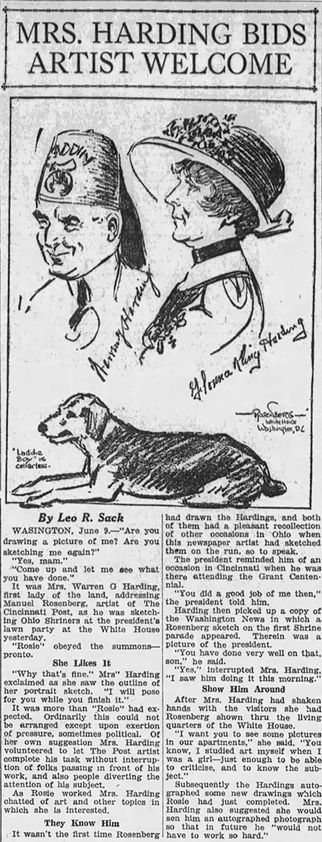
By Lee R. Sack
WASHINGTON, June 9 -“Are you drawing a picture of me? Are you sketching me again?” “Yes, mam.” “Come up and let me see what you have done.” It was Mrs. Warren G. Harding, first lady of the land, addressing Manuel Rosenberg, artist of The Cincinnati Post, as he was sketching Ohio Shriners at the president’s lawn party at the White House yesterday. “Rosie” obeyed the summons—pronto.
She Likes It.
“Why that’s fine,” Mrs. Harding exclaimed as she saw the outline of her portrait sketch. “I will pose for you while you finish it.” It was more than “Rosie” had expected. Ordinarily this could not be arranged except upon exertion of pressure, sometimes political. Of her own suggestion Mrs. Harding volunteered to let The Post artist complete his task without interruption of folks passing in front of his work, and also people diverting the attention of his subject. As Rosie worked Mrs. Harding chatted of art and other topics in which she is interested.
They Know Him
It wasn’t the first time Rosenberg had drawn the Hardings, and both of them had a pleasant recollection of other occasions in Ohio when this newspaper artist had sketched them on the run, so to speak. The president reminded him of an occasion in Cincinnati when he was there attending the Grant Centennial. “You did a good job of me then,” the president told him. Harding then picked up a copy of the Washington News in which a Rosenberg sketch on the first Shrine parade appeared. Therein was a picture of the president. “You have done very well on that, son,” he said. “Yes,” interrupted Mrs. Harding, “I saw him doing it this morning.”
Show Him Around
After Mrs. Harding had shaken hands with the visitors she had Rosenberg shown thru the living quarters of the White House.“I want you to see some pictures in our apartments,” she said. “You know, I studied art myself when I was a girl—just enough to be able to criticize, and to know the subject.” Subsequently the Hardings autographed some new drawings which Rosie had just completed. Mrs. Harding also suggested she would send him an autographed photograph so that in future he “would not have to work so hard.”
Cincinnati Post - June 9, 1923